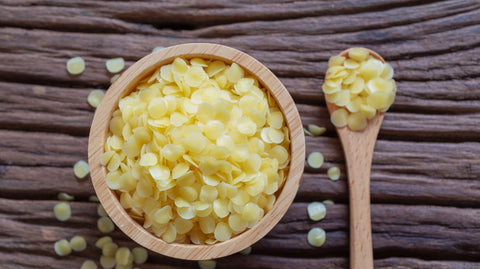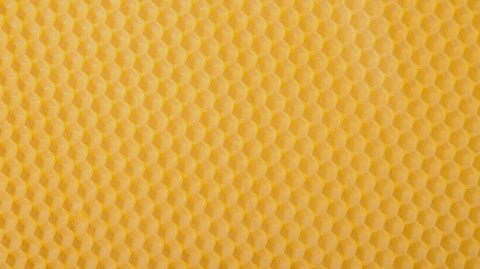Beeswax has been used for centuries as a natural, versatile resource with countless applications. Produced by honeybees, this golden wax is more than just the foundation of honeycombs. It is a valuable material that can be used throughout the home in ways that are both practical and eco-friendly. Unlike synthetic products, beeswax is non-toxic, renewable, and biodegradable, making it a safe and sustainable choice for everyday living.
From polishing wood to making natural skincare, beeswax proves itself to be an item worth keeping on hand. Whether you enjoy DIY projects, want to reduce your reliance on chemical products, or are looking for sustainable household alternatives, beeswax can help. Below are 10 everyday uses for beeswax around the house that show just how versatile this natural product really is.
1. Homemade Candles
One of the most popular and traditional uses of beeswax is candle making. Beeswax candles are prized for their natural beauty, subtle honey scent, and clean burn. Unlike paraffin candles that are petroleum-based, beeswax candles are made from a renewable source and produce very little soot. They also burn longer, making them more cost-effective over time.
Making your own candles at home is simple with beeswax. You can melt the wax, add a natural cotton wick, and pour it into a jar or mold for a custom candle. These candles provide a warm, golden glow that adds charm to any room and makes a thoughtful handmade gift.
2. Food Wraps and Storage
Plastic wrap is convenient, but it is also single-use and contributes to environmental waste. Beeswax wraps have become a popular eco-friendly alternative. These reusable wraps are made by infusing fabric, typically cotton, with melted beeswax, sometimes blended with resin and jojoba oil for flexibility.
Once the wrap cools, it can be molded around food items or containers using the warmth of your hands. Beeswax wraps are perfect for covering bowls, wrapping sandwiches, or storing fruits and vegetables. They can be washed with cool water and mild soap, then reused for up to a year. This makes them a sustainable and cost-saving option for households looking to cut down on disposable plastics.
3. Wood Furniture Polish
Wood furniture can lose its shine over time, but beeswax is a natural solution for restoring its beauty. Beeswax polish not only brings out the natural grain of the wood but also creates a protective layer that repels dust and moisture.
To make your own beeswax wood polish, combine melted beeswax with a natural oil such as olive oil or coconut oil. Apply the mixture with a soft cloth, let it sit for a few minutes, then buff the surface until it shines. This simple method nourishes the wood, enhances its durability, and avoids the harsh chemicals found in many commercial polishes.
4. Leather Conditioner
Leather products such as shoes, belts, and bags benefit from regular conditioning to prevent cracking and wear. Beeswax is an excellent natural leather conditioner because it softens, waterproofs, and protects leather surfaces.
By applying a small amount of melted beeswax (sometimes mixed with oil for spreadability), you can revive old leather items and extend their lifespan. The wax penetrates the leather to keep it supple, while the protective layer it leaves behind helps guard against water and stains. This makes beeswax a reliable option for maintaining everything from work boots to handbags.
5. Natural Skin Care
Beeswax has long been used in skincare products because of its ability to lock in moisture and protect the skin. Unlike petroleum-based ingredients, beeswax allows the skin to breathe while still creating a natural barrier.
In homemade balms and lotions, beeswax helps thicken the product while also adding soothing qualities. It is often combined with oils such as almond or coconut oil to create lip balms, hand creams, and salves. Many people prefer beeswax-based skincare because it is gentle, safe for sensitive skin, and free from synthetic additives. Making your own products at home ensures you know exactly what goes into them.
6. Lubricant for Stuck Drawers and Zippers
If you have a drawer that sticks or a zipper that will not glide smoothly, beeswax offers a quick and natural fix. By rubbing a block of beeswax along the edges of a sticky drawer or directly onto a zipper’s teeth, you reduce friction and make movement easier.
This method also works for squeaky door hinges or stubborn sliding doors. Because beeswax is non-toxic and leaves behind no harmful residue, it is a safe alternative to chemical lubricants, especially in households with children or pets.
7. Sewing Aid
Sewers and crafters often use beeswax to strengthen thread and reduce tangling. By running thread through a block of beeswax before stitching, you coat the fibers, making them smoother and more resistant to fraying.
This technique is especially helpful for hand-sewing projects, embroidery, and quilting. Waxed thread glides more easily through fabric and is less likely to knot. It is a small step that can make a big difference in the quality and ease of sewing projects.
8. Rust Prevention
Tools, garden equipment, and even kitchen items made of metal can rust over time when exposed to moisture. Beeswax provides a natural coating that helps prevent oxidation and rust. Simply rub a thin layer of beeswax onto the surface of clean, dry metal tools, then buff lightly.
This creates a protective barrier that repels water and prolongs the life of your equipment. Many woodworkers and gardeners use this method to keep their tools in good condition without relying on chemical sprays. It is an easy and sustainable way to maintain your investments.
9. Fire Starters
Beeswax is also useful for creating natural fire starters that are safe and effective. By combining melted beeswax with materials like cotton balls, pine cones, or wood shavings, you can make compact starters that ignite quickly and burn steadily.
These fire starters are ideal for camping trips, fireplaces, or wood stoves. They are easy to store, lightweight to carry, and do not rely on synthetic chemicals. Making your own beeswax fire starters is not only practical but also a fun DIY project for families.
10. Arts and Crafts Projects
Beeswax has a place in creative projects as well. It is commonly used in encaustic painting, an art form that involves mixing colored pigments with melted beeswax to create textured, layered artworks. It can also be used in batik fabric dyeing, where wax is applied to fabric to resist dyes and create patterns.
For children and crafters, beeswax can even be used to make homemade crayons or modeling wax. These projects are safe, non-toxic, and encourage creativity while providing an eco-friendly alternative to store-bought materials. Beeswax’s flexibility makes it a valuable tool in both serious art forms and everyday crafts.
Final Thoughts About Uses For Beeswax
Beeswax is more than just a byproduct of beekeeping. It is a powerful, versatile material that can be used around the house in dozens of practical ways. From polishing furniture to creating skincare products, beeswax offers natural solutions that replace synthetic alternatives. By incorporating beeswax into your household, you can save money, reduce waste, and enjoy the benefits of a safe, sustainable product.
Whether you make your own candles, wraps, or polishes, or purchase ready-made beeswax items, this natural resource has endless potential. Keeping a block or jar of beeswax on hand allows you to explore its many everyday uses and discover why it has been treasured for centuries.
For high-quality beeswax products straight from the hive, look no further than Ames Farm. Known for their commitment to sustainable beekeeping and single-source honey, Ames Farm also provides pure beeswax that is perfect for candles, wraps, polishes, and countless household projects. Choosing Ames Farm means supporting local beekeepers while bringing authentic, natural products into your home.


